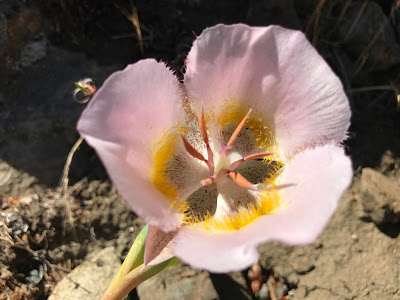 |
| The upper slopes of Bald Mountain support a diverse mosaic of habitats, including grassland, shrubland, oak woodland and dry mixed conifer forest. |
Like much of the Klamath-Siskiyou Mountains the diverse soils, steep environmental gradients and complex topography of Bald Mountain create beautifully contrasting ecosystems. The mountain's harsh south and west facing slopes support a diverse mixture of high desert and California foothill species, where oak woodland, arid grassland, chaparral, and dry mixed conifer forest mingle with small populations of western juniper and species more commonly found in the sagebrush steppe east of the Cascade Mountains. Meanwhile, the mountain's north and east facing slopes are dominated by relatively moist conifer forests with lush understory vegetation indicative of the Pacific Northwest.
 |
| Siskiyou Mariposa lily blooming on Bald Mountain. |
 |
| Henderson's lomatium blooming on Bald Mountain. |
 |
| Tall bugbane blooming on Bald Mountain. |
The understory in these forests can be quite lush and abundant with species indicative of moist forest clearings. The vibrant, green forest floor contains swaths of flowering herbaceous species such as Bleeding heart (Dicentra formosa), Starry false Soloman's seal (Maianthemum stellatum), Candy flower (Claytonia siberica), Stream violet (Viola glabella) and large colonies of tall bugbane. Much of this understory remains green late into the fire season and creates a natural fuel brake along the ridgeline. This phenomena lasts late into the summer after the adjacent south and west facing slopes have dried out and become acutely flammable.
Unfortunately, these same forests are also littered in bright orange flagging delineating timber sale unit boundaries, and the trees have been stripped in florescent orange paint, marking the trees that would be retained in unit 21-2 of the BLM's Bear Grub Timber Sale. The remaining unmarked trees would be logged, removing much of the forest complexity, opening and drying out these exposed ridgetop stands, encouraging the development of dense woody regeneration, increasing fire hazards, promoting further canopy loss through windthrow, and eliminating abundant natural snag and downed wood recruitment.
If the BLM approves these units, trees will be felled and yarded in the clearings and throughout the open forest that currently supports such beautiful herbaceous plant communities and robust populations of tall bugbane. The soil disturbance and vegetative damage associated with logging activity is certain to impact this unique tall bugbane population, introduce non-native and noxious species and impact the surprisingly lush and abundant herbaceous understory found on Bald Mountain's northeastern slope.
The BLM has also proposed two more Bear Grub Timber Sale units (unit 27-4 and 27-8) along the spine of Bald Mountain. These forests are drier than unit 21-2, but still support open groves of fire resistant old forest. The BLM is proposing to log trees between 20" and 41" diameter in these units. The loss of canopy will dry out these stands, recruit dense, highly flammable understory vegetation, increase fire hazards, and degrade wildlife habitat in a vital connectivity corridor connecting Anderson Butte, the foothills of the Applegate Valley and the Siskiyou Crest.
The area is important for wildlife and represents a narrow "bottleneck" in connectivity between the Siskiyou Crest and the Applegate foothills. The forests around Wagner Gap have been heavily logged in recent years by private industrial timber interests, and historic clearcut logging on BLM lands has left only a narrow corridor or mature forest and intact habitat on the ridgeline of Bald Mountain. These last wild forests and the wildlife habitat they create are particularly important for species such as Great grey owls, Pacific fisher, Northern spotted owls and others that require complex forest for denning or nesting habitat. They are also important for species such as elk and black tailed deer that overwinter in the lower elevation foothills surrounding the Applegate Valley, but migrate during the summer months to utilize high elevation habitats on the Siskiyou Crest.
Bald Mountain is a special place, with extremely high biological values. The area should be protected as the Bald Mountain Area of Critical Environmental Concern (ACEC) and withdrawn from the BLM's "timber harvest land base." Those who know Bald Mountain value it for the connectivity it provides, for it's biodiversity, rare plant species, spectacular wildflower displays, wildlife habitats and beautiful old forests, Unfortunately, BLM does not support those values and has proposed management activities that will not sustain the region's biodiversity and connectivity into the future.
Please join Klamath Forest Alliance as we work to protect Bald Mountain from the Bear Grub Timber Sale.
For more information visit:
STOP BEAR GRUB!


